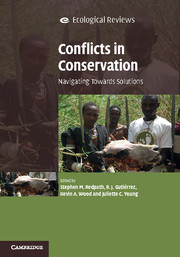Book contents
- Frontmatter
- Dedication
- Contents
- List of contributors
- Foreword by Georgina Mace
- Acknowledgements
- Part I Introduction to conservation and conflict
- PART II Contrasting disciplinary approaches to the study of conflict in conservation
- Part III Approaches to managing conflicts
- 14 Modelling conservation conflicts
- 15 Defining scales for managing biodiversity and natural resources in the face of conflicts
- 16 Mediation and conservation conflicts: from top-down to bottom-up
- 17 Designing and facilitating consensus-building – keys to success
- 18 Conservation conflict transformation: the missing link in conservation
- 19 Legislated collaboration in a conservation conflict: a case study of the Quincy Library Group in California, USA
- 20 Finding a way out of conservation conflicts
- Index
- Plate Section
- References
17 - Designing and facilitating consensus-building – keys to success
from Part III - Approaches to managing conflicts
Published online by Cambridge University Press: 05 May 2015
- Frontmatter
- Dedication
- Contents
- List of contributors
- Foreword by Georgina Mace
- Acknowledgements
- Part I Introduction to conservation and conflict
- PART II Contrasting disciplinary approaches to the study of conflict in conservation
- Part III Approaches to managing conflicts
- 14 Modelling conservation conflicts
- 15 Defining scales for managing biodiversity and natural resources in the face of conflicts
- 16 Mediation and conservation conflicts: from top-down to bottom-up
- 17 Designing and facilitating consensus-building – keys to success
- 18 Conservation conflict transformation: the missing link in conservation
- 19 Legislated collaboration in a conservation conflict: a case study of the Quincy Library Group in California, USA
- 20 Finding a way out of conservation conflicts
- Index
- Plate Section
- References
Summary
I am writing this chapter as someone who has designed and facilitated over 70 stakeholder processes, reviewed others, conducted research on best practice (e.g. Pound, 2009) and trained and learnt from the experiences of over 1000 people. I do this through Dialogue Matters, established in 2000 to focus on dialogue about the environment. We work from local to international scales, low to high levels of tension, and between sectors and cultures. Our work includes conflict resolution between resource users, between users and conservationists, and also topic-based dialogue where the science and policy is contested (e.g. climate change, global water futures and solutions, sustainable fishing practice, managing bovine tuberculosis (TB) in cattle and badgers).
Our approach continues to evolve but is rooted in Consensus-building, more often now called Stakeholder Dialogue. This has particular ethics and design principles which set it apart from other participatory approaches. It involves a group of stakeholders in a face-to-face and principled negotiation process, designed for the situation and comprising a staged sequence of deliberative workshops and other activities. In our own work, to maximise the benefits of the process and the number that can be involved, our professional team train, lead and work alongside volunteer small group facilitators.
In this chapter I describe 12 keys to success related to consensus-building. I use ‘tension’ rather than ‘conflict’ because there is a gradation from low tension (parties recognise different perspectives but are willing to cooperate) to full conflict (parties are polarised, have no direct contact and the conflict is escalating). ‘Sponsoring bodies’ are organisations (e.g. government agencies, NGOs or partnerships) that provide the resources for a stakeholder process. Their motivation may be compliance with statutory requirements, a principled commitment to participation or, most likely, because they want well-informed decisions that have greater support and are easier to implement. ‘Projects’ are the people and enterprise put together to achieve a particular aim. Projects may sit within larger organisations that are the sponsoring body, or be a partnership between organisations and be the sponsoring body.
- Type
- Chapter
- Information
- Conflicts in ConservationNavigating Towards Solutions, pp. 240 - 256Publisher: Cambridge University PressPrint publication year: 2015
References
- 3
- Cited by

